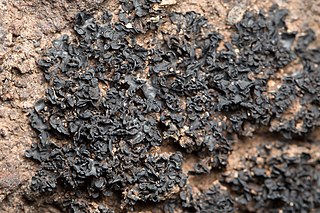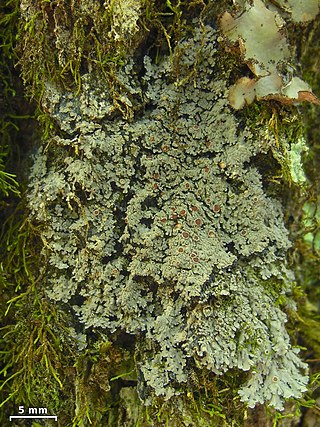
The Lichinaceae are a family of ascomycete fungi. Most species are lichenized with cyanobacteria, and have a distribution largely in temperate regions.

Protopannaria is a genus of seven species of lichenized fungi in the family Pannariaceae. The genus was originally circumscribed as a subgenus of the genus Pannaria by Hungarian lichenologist Vilmos Kőfaragó-Gyelnik. Per Magnus Jørgensen and Stefan Ekman promoted Protopannaria to full status as a genus in 2000.

Fuscopannaria is a genus of lichen-forming fungi in the family Pannariaceae. It has 55 species.
Fuscoderma is a genus of lichenized fungi in the family Pannariaceae. It was originally circumscribed as a subgenus of the genus Leioderma by David Galloway and Per Magnus Jørgensen in 1987. The same authors promoted it to generic status a couple of years later in 1989. The New Guinean species F. papuanum was added to the genus in 2002.

Degelia is a genus of lichen-forming fungi in the family Pannariaceae. The genus is named after Swedish lichenologist Gunnar Degelius.
Anema is a genus of lichen within the family Lichinaceae. The genus contains at least 13 species.
Lichinodium is a genus of filamentous lichens. It is the only genus in the family Lichinodiaceae, itself the only member of the order Lichinodiales. Lichinodium has four species. Previously considered part of the class Lichinomycetes, molecular phylogenetic analysis revealed that Lichinodium represents a unique lineage in the Leotiomycetes—the first known group of lichen-forming fungi in this class.
Mawsonia is a fungal genus in the family Lichinaceae. It is a monospecific genus, containing the single species Mawsonia harrissonii, a rare saxicolous, crustose lichen found in Antarctica.
Zahlbrucknerella is a genus of filamentous, rock-dwelling lichens in the family Lichinaceae.

Thyrea is a genus of lichen-forming fungi in the family Lichinaceae. It contains four species that have been accepted by Species Fungorum. The genus was circumscribed by Italian lichenologist Abramo Bartolommeo Massalongo in 1856, with Thyrea plectospora assigned as the type species.
Leciophysma is a genus of cyanolichens in the family Pannariaceae. It has four species. The genus was circumscribed by Theodor Magnus Fries in 1865, with Leciophysma finmarkicum assigned as the type species.
Staurolemma is a genus of lichenized fungi in the family Pannariaceae. The genus was circumscribed by German lichenologist Gustav Wilhelm Körber in 1867, with Staurolemma dalmaticum as the type species.

Leptochidium is a genus of lichen-forming fungi in the family Massalongiaceae. It has two species:
Arctomia is a genus of lichen-forming fungi in the family Arctomiaceae. The genus was originally circumscribed by Theodor Magnus Fries in 1861. Arctomia has a circumpolar distribution.
Harpidiaceae is a small family of lichen-forming fungi, containing two genera and five species. It is of uncertain classification in the Pezizomycotina.
Tingiopsidium is a genus of lichen-forming fungi in the family Koerberiaceae. The genus was circumscribed in 1939 by French botanist Roger-Guy Werner, with Tingiopsidium pubescens assigned as the type species. Vestergrenopsis, a genus proposed by Vilmos Kőfaragó-Gyelnik in 1940, was shown to contain a species that is the type of Tingiopsidium, and because Tingiopsidium was published a year earlier, the principle of priority makes Vestergrenopsis illegitimate, and a synonym of Tingiopsidium.

Peccania tiruncula is a species of saxicolous (rock-dwelling), squamulose to dwarf fruticose lichen in the family Lichinaceae. It was first described as a new species in 1878 by the Finnish lichenologist William Nylander, who classified it in the genus Omphalaria. The type specimen was collected by Johan Petter Norrlin in Biskra. Aino Henssen transferred it to the genus Peccania in 1990.
Pseudoheppia is a fungal genus in the family Lichinaceae. It contains a single species, Pseudoheppia schuleri, a saxicolous (rock-dwelling) squamulose lichen.

Gloeoheppia is a genus of lichen-forming fungi in the family Gloeoheppiaceae. It comprises five species. The genus is distinguished from similar-looking lichens like Heppia by its internal structure, the nature of its photobiont, and details of its reproductive structures.
Metamelanea is a small genus of lichen-forming fungi in the family Lichinaceae. It consists of three species of rock-dwelling lichens.








